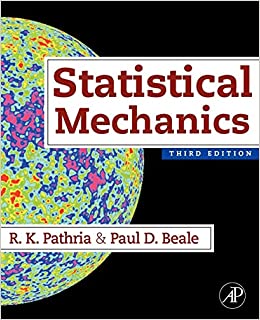The configurational energy of the lattice is given by [ begin{aligned} E= & frac{1}{2} q Nleft[varepsilon_{11} cdot
Question:
The configurational energy of the lattice is given by
\[
\begin{aligned}
E= & \frac{1}{2} q N\left[\varepsilon_{11} \cdot x_{A}(1+X) \cdot x_{A}(1-X)+\varepsilon_{12}\left\{x_{A}(1+X)\left(x_{B}+x_{A} X\right)\right.\right. \\
& \left.\left.+x_{A}(1-X)\left(x_{B}-x_{A} X\right)\right\}+\varepsilon_{22}\left(x_{B}-x_{A} X \right)\left(x_{B}+x_{A} X\right)\right] \\
= & \frac{1}{2} q N\left[\left(\varepsilon_{11} x_{A}^{2}+2 \varepsilon_{12} x_{A} x_{B}+\varepsilon_{22} x_{B}^{2}\right)-2 \varepsilon x_{A}^{2} X^{2}\right] \quad\left[\varepsilon=\frac{1}{2}\left(\varepsilon_{11}+\varepsilon_{22}\right)-\varepsilon_{12}\right] .
\end{aligned}
\]
The entropy, on the other hand, is given by
\[
\begin{aligned}
S= & k\left[\ln \left(\frac{1}{2} N\right) !-\ln \left\{\frac{1}{2} N x_{A}(1+X)\right\} !-\ln \left\{\frac{1}{2} N\left(x_{B}-x_{A} X\right)\right\} !+\right. \\
& \left.\ln \left(\frac{1}{2} N\right) !-\ln \left\{\frac{1}{2} N x_{A}(1-X)\right\} !-\ln \left\{\frac{1}{2} N\left(x_{B}+x_{A} X\right)\right\} !\right] \\
\approx & \frac{1}{2} N k\left[-x_{A}(1+X) \ln \left\{x_{A}(1+X)\right\}-\left(x_{B}-x_{A} X\right) \ln \left(x_{B}-x_{A} X\right)\right. \\
& \left.\quad-x_{A}(1-X) \ln \left\{x_{A}(1-X)\right\}-\left(x_{B}+x_{A} X\right) \ln \left(x_{B}+x_{A} X\right)\right] .
\end{aligned}
\]
To determine the equilibrium value of \(X\), we minimize the free energy of the system and obtain
\[
\begin{equation*}
\frac{\partial(E-T S)}{\partial X}=-2 q N \varepsilon x_{A}^{2} X+\frac{1}{2} N k T x_{A} \ln \left\{\frac{(1+X)\left(x_{B}+x_{A} X\right)}{(1-X)\left(x_{B}-x_{A} X\right)}\right\}=0 . \tag{1}
\end{equation*}
\]
Now, since \(x_{A}+x_{B}=1\), the argument of the logarithm can be written as \((1+z) /(1-z)\), where \(z=X /\left(x_{B}+x_{A} X^{2}\right)\). Equation (1) then takes the form
\[
\begin{equation*}
\frac{2 q \varepsilon x_{A} X}{k T}=\frac{1}{2} \ln \frac{1+z}{1-z}=\tanh ^{-1} z, \tag{2}
\end{equation*}
\]
which is identical with the result quoted in the problem. For \(x_{A}=x_{B}=\frac{1}{2}\), eqn. (2) reduces to the more familiar result
\[
\begin{equation*}
\frac{q \varepsilon X}{k T}=\tanh ^{-1} \frac{2 X}{1+X^{2}}=2 \tanh ^{-1} X \tag{2a}
\end{equation*}
\]
leading to a phase transition at the critical temperature \(T_{c}^{0}=q \varepsilon / 2 k\).
To determine the transition temperature \(T_{c}\) in the general case when \(x_{A} eq\) \(x_{B}\), we go back to eqn. (2) and write it in the form
\[
\begin{equation*}
\frac{X}{x_{B}+x_{A} X^{2}}=\tanh \left(\frac{4 x_{A} T_{c}^{0}}{T} X\right) \tag{3}
\end{equation*}
\]
For small \(X\), we get
\[
\begin{aligned}
& \frac{1}{x_{B}} X-\frac{x_{A}}{x_{B}^{2}} X^{3}+\ldots=\frac{4 x_{A} T_{c}^{0}}{T} X-\frac{1}{3}\left(\frac{4 x_{A} T_{c}^{0}}{T}\right)^{3} X^{3}+\ldots, \text { i.e. } \\
& \frac{1}{x_{B}}\left(\frac{4 x_{A} x_{B} T_{c}^{0}}{T}-1\right) X-\frac{1}{3 x_{B}^{3}}\left[\left(\frac{4 x_{A} x_{B} T_{c}^{0}}{T}\right)^{3}-3 x_{A} x_{B}\right] X^{3}+\ldots=0 .
\end{aligned}
\]
It is now straight forward to see that for \(T<4 x_{A} x_{B} T_{c}^{0}\), a non-zero solution for \(X\) is possible whereas for \(T \geq 4 x_{A} x_{B} T_{c}^{0}, X=0\) is the only possibility. The transition temperature \(T_{c}\) is, therefore, given by \(4 x_{A}\left(1-x_{A}\right) T_{c}^{0}\).
Step by Step Answer:






